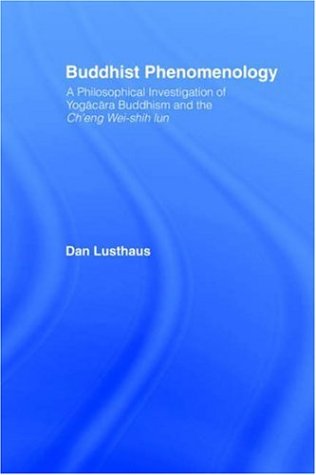

Most ebook files are in PDF format, so you can easily read them using various software such as Foxit Reader or directly on the Google Chrome browser.
Some ebook files are released by publishers in other formats such as .awz, .mobi, .epub, .fb2, etc. You may need to install specific software to read these formats on mobile/PC, such as Calibre.
Please read the tutorial at this link. https://ebooknice.com/page/post?id=faq
We offer FREE conversion to the popular formats you request; however, this may take some time. Therefore, right after payment, please email us, and we will try to provide the service as quickly as possible.
For some exceptional file formats or broken links (if any), please refrain from opening any disputes. Instead, email us first, and we will try to assist within a maximum of 6 hours.
EbookNice Team

Status:
Available0.0
0 reviews
ISBN-10 : 0700711864
ISBN-13 : 9780700711864
Author: Dan Lusthaus
A richly complex study of the Yogacara tradition of Buddhism, divided into five parts: the first on Buddhism and phenomenology, the second on the four basic models of Indian Buddhist thought, the third on karma, meditation and epistemology, the fourth on the Trimsika and its translations, and finally the fifth on the Ch'eng Wei-shih Lun and Yogacara in China.
Part One Buddhism and Phenomenology
Chapter One Buddhism and Phenomenology
What is(n't) Yogācāra?
Alterity
Chapter Two Husserl and Merleau-Ponty
The Hyle
The Intentional Arc
Part Two The Four Basic Buddhist Models in India
Introduction
Chapter Three Model One: The Five Skandhas
Chapter Four Model Two: Pratītya-samutpāda
Chapter Five Model Three: Tridhātu
Kāma-dhātu
Rūpa-dhātu
Ārūpya-dhātu
Chapter Six Model Four: Śīla-Samādhi-Prajñā
Śīla
Samādhi
Prajñā
Chapter Seven Asaṃjñi-samāpatti and Nirodha-samāpatti
Karma and Āsavas
Impurities and Contaminants
Saññā-vedayita-nirodha in Nikāyas
Visuddhimagga
Abhidhammattha Sangaha of Bhadanta Anuruddhācariya
Abhidharmakośa
Passages from Yogācāra texts
Ch'eng wei-shih lun on Nirodha-samāpatti
Postscript
Chapter Eight Summary of the Four Models
Part Three Karma, Meditation, and Epistemology
Chapter Nine Karma
General Description
Karma Does Not Explain Everything
Is Buddhism a Psychologism?
Karma: The Circuit of Intentionality
Karma and Rūpa
Yogācāra Karmic Theory
Chapter Ten Mādhyamakan Issues
Madhyamaka and Karma
Karma-kleśa
Moral Karma
Karma and the Soteric
Saṃskār
Madhyamaka and the Two Satyas
Closure and Referentiality
Madhyamaka and the Four Models
Chapter Eleven The Privileging of Prajñā: Prajñā-pāramitā
Privileging Nāṇa in the Pāli Abhidhamma
Tathatā: Essentialism or Progressionalism?
Prajñāpāramitā: Essentialism or Episteme?
Pāli Texts on Sudden and Gradual
Essentialism vs. Progressionalism
Implications: Rūpa and the Three Worlds, Again
Part Four Triṃśikā and Translations
Chapter Twelve Texts and Translations Sanskrit Text of the Triṃśikā, Chinese texts of the renditions of Paramārtha and Hsüan-tsang, Separate English translations of all three versions, with detailed expository and comparative annotations
Part Five The Ch'eng Wei-Shih Lun and the Problem of Psychosophical Closure: Yogācāra in China
Chapter Thirteen Background Sketches of Pre-T'ang Chinese Buddhism
Chapter Fourteen Seven Trajectories
The failure of Indian Logic in China
The Prajñā schools
Deviant Yogācāra
Hsiang hsing (“characteristic and nature”) in the Ch'eng wei-shih lun
Chapter Fifteen The Legend of the Transmission of the Ch'eng wei-shih lun
K'uei-chi's Situation
K'uei-chi's transmission story
Translation of story from Ch'eng-wei-shih-lun shu-yao
The Twelve Imperial Symbols
K'uei-chi's Catechism and ‘Secret’ Lineage Transmission
Problems with a Śīlabhadra ‘lineage’
Hsüan-tsang's Reticence
Is Dharmapāla's Interpretation the Dominant One? Evidence from Fo-ti ching lun
Hsüan-tsang and Dharmapāla
Prasenajit,
If not Dharmapāla?
Chapter Sixteen Alterity: Pariṇāma
The Alterity of Consciousnesses
Is “Vijñapti-mātra” an Ontological or Epistemological Notion?
Chapter Seventeen Why Consciousness in Not Empty
Saṃvṛti, Paramārtha, and Language according to Bhāvaviveka
Candrakīrti's Chimera
What is Real in Yogācāra?
Means of Valid Knowledge in the Ch'eng wei-shih lun
Why Consciousness is not Empty
Chapter Eighteen On Rūpa
Types of Vāsanā
Interlude: Some Ideas about the “Cognitive Object” in Western Philosophy
Yogācāra on Rūpa, Again
Chapter Nineteen Externality
Rejection of the ‘One Mind’ Theory: Other Minds
The ‘Mirror’ Metaphor
Vallée Poussin's ‘Idealist’ Interpretation
Chapter Twenty The Four Conditions
Hetu-pratyaya
Samanantara-pratyaya
Ālambana-pratyaya
The Hyle (Chih )
Adhipati-pratyaya
Some Implications of the Four Pratyayas
Chapter Twenty One Mirror Knowing: Soteric Alterations
Chapter Twenty Two Language, Avijñapti-rūpa and Vijñapti-Rūpa
On Language and Reality
Vijñapti-rūpa and Avijñapti-rūpa
Chapter Twenty Three Is What is Ultimately Real Itself Ultimately Real?
Conclusion
Appendices
The One Hundred Dharmas
Seventy-five Dharmas
Comparison of One Hundred and Seventy-five Dharmas
Hsüan-tsang's translations and works
Bibliography
buddhist phenomenology pdf
buddhist phenomenology
japanese buddhist philosophy
quantum physics and buddhist philosophy
tibetan buddhist philosophy
Tags: Buddhist phenomenology, philosophical investigation, Yogācāra Buddhism, Cheng Wei, Dan Lusthaus